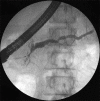Current status of endotherapy for chronic pancreatitis
- PMID: 25630314
- PMCID: PMC4291997
- DOI: 10.11622/smedj.2014173
Current status of endotherapy for chronic pancreatitis
Abstract
Chronic pancreatitis is associated with varied morphological complications, including intraductal stones, main pancreatic ductal strictures, distal biliary strictures and pseudocysts. Endoscopic therapy provides a less invasive alternative to surgery. In addition, extracorporeal shockwave lithotripsy improves the success rate of endoscopic clearance of intraductal stones. However, recent data from randomised trials have shown better long-term outcomes with surgical drainage for obstructive pancreatic ductal disease. In patients with distal biliary strictures, stent insertion leads to good immediate drainage, but after stent removal, recurrent narrowing is common. Endoscopic drainage of pancreatic pseudocysts has excellent outcome and should be accompanied by pancreatic ductal stenting when a ductal communication is evident. In those who remain symptomatic, endoscopic ultrasonography-guided coeliac plexus block may provide effective but short-term pain relief. In this review, we present the current evidence for the role of endotherapy in the management of patients with chronic pancreatitis.
Figures




References
-
- Etemad B, Whitcomb DC. Chronic pancreatitis: diagnosis, classification, and new genetic developments. Gastroenterology. 2001;120:682–707. - PubMed
-
- Braganza JM, Lee SH, McCloy RF, McMahon MJ. Chronic pancreatitis. Lancet. 2011;377:1184–97. - PubMed
-
- Maydeo A, Soehendra N, Reddy N, Bhandari S. Endotherapy for chronic pancreatitis with intracanalar stones. Endoscopy. 2007;39:653–8. - PubMed
-
- Ammann RW, Muench R, Otto R, et al. Evolution and regression of pancreatic calcification in chronic pancreatitis. A prospective long-term study of 107 patients. Gastroenterology. 1988;95:1018–28. - PubMed
Publication types
MeSH terms
LinkOut - more resources
Full Text Sources
Other Literature Sources

